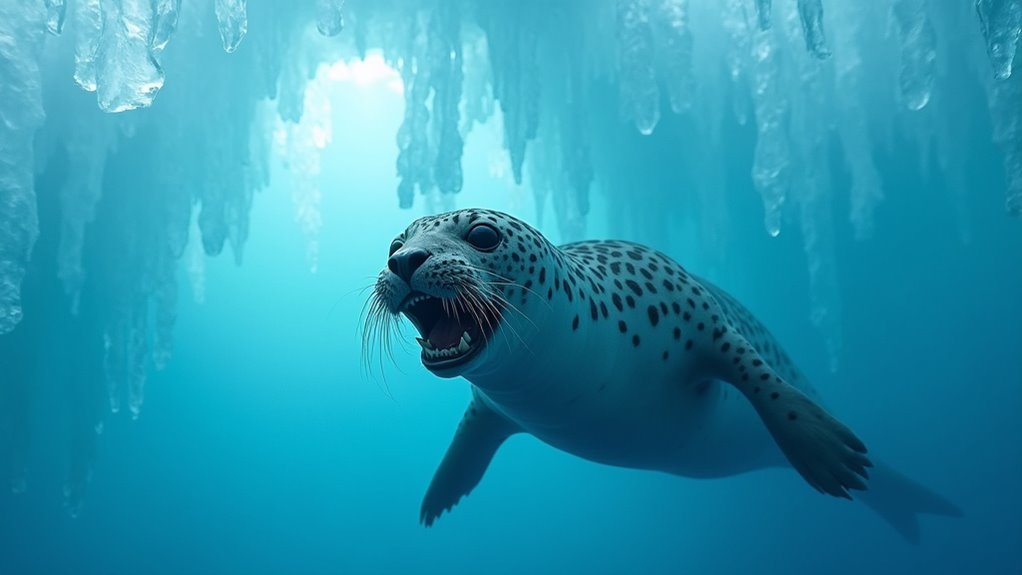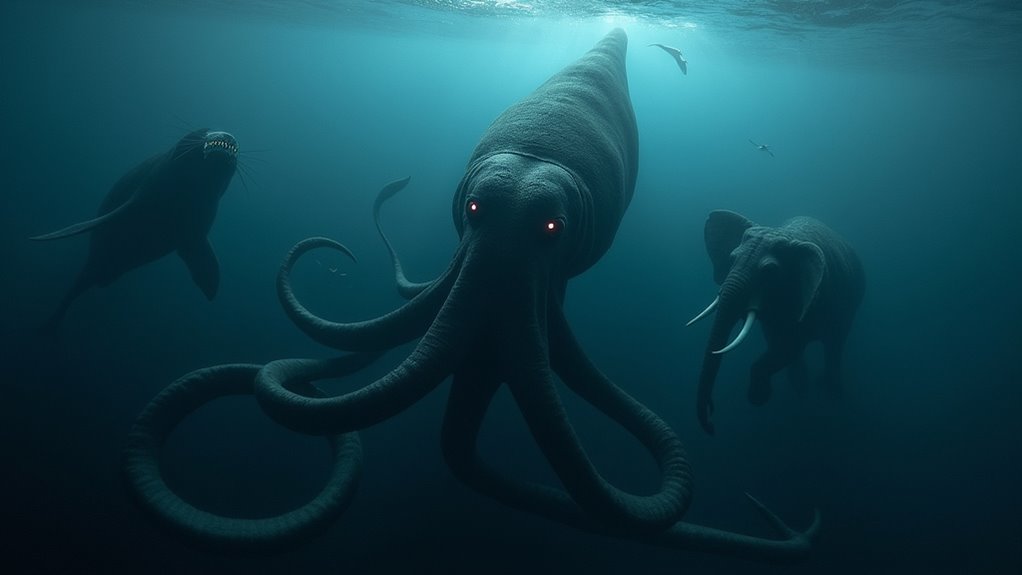Physical Address
304 North Cardinal St.
Dorchester Center, MA 02124
Physical Address
304 North Cardinal St.
Dorchester Center, MA 02124

Sinister predators lurk beneath Antarctica's icy surface, from leopard seals with deadly canines to aggressive elephant seals protecting their harems.
Antarctica’s most dangerous animals include leopard seals with their 2.5 cm canines that ambush prey, and orcas that hunt cooperatively in pods. You’ll face serious threats from southern elephant seals during breeding season when bulls protect harems. Giant petrels aggressively scavenge with projectile vomit defenses, while mysterious colossal squid possess hooked tentacles. Don’t overlook Antarctic skuas that dive-bomb human intruders near nests. Each creature presents unique dangers in the continent’s harsh environment.

When it comes to Antarctica’s most fearsome predators, the leopard seal stands at the top of the food chain. These massive carnivores can reach nearly 4 meters in length, with females growing larger than males—weighing up to 500 kg.
You’ll find these solitary hunters throughout the Antarctic pack ice, where they use their slender, agile bodies to move swiftly through water. Don’t be fooled by their graceful swimming—leopard seals are aggressive territorial defenders and skilled hunters that often ambush penguins at the ice edge.
With no natural predators and a population between 220,000-440,000, these apex predators are masters of stealth. Their dark-spotted bodies blend perfectly with the icy waters, allowing them to strike with deadly precision. Their massive jaws contain specialized teeth, including canines that can grow up to 2.5 cm long, perfect for capturing and tearing apart prey.
While leopard seals may dominate the pack ice, orcas reign supreme throughout Antarctica’s waters as the undisputed masters of the marine environment. These massive members of the dolphin family can reach lengths of 9 meters, with their distinctive black-and-white coloration making them instantly recognizable.
Orcas: Antarctica’s apex predators, with unmistakable coloration and impressive size, rule the southern seas unchallenged.
You’ll find approximately 70,000 orcas in Antarctic waters, where they live in matriarchal pods of 5-30 individuals. Five distinct Antarctic ecotypes have been identified, each with different behaviors, diets, and physical characteristics. They’re incredibly adaptable hunters, using cooperative tactics to create waves that wash prey off ice floes.
Their diet includes everything from fish and penguins to seals and even other whales.
With no natural predators as adults, orcas play a vital role in Antarctica’s ecosystem by regulating marine mammal and fish populations. Their intelligence, size, and hunting prowess make them truly formidable predators.

Southern elephant seals represent one of Antarctica’s most imposing physical threats, despite their normally docile nature outside of breeding season. During September to November, these giants transform into territorial beasts, with bulls weighing up to 8,800 pounds—nearly five tons of aggressive muscle and blubber.
If you’re visiting Antarctic shores during mating season, keep well away from breeding colonies. Bulls arrive first, establishing harems of up to 150 females that they’ll defend with shocking violence.
They’ll charge at perceived threats without hesitation, including humans. Their sheer size means even accidental contact could be deadly—bulls can crush you without intending harm. These battles are especially dangerous as males fight fiercely using their large proboscis and powerful bites to establish dominance over rivals.
What makes them particularly dangerous is their unpredictable movement patterns and willingness to attack without provocation when protecting territory.
Among Antarctica’s most dangerous birds, giant petrels have earned their nicknames “Stinkers” and “Gluttons” through their aggressive behavior and voracious appetite for carrion. You’d want to keep your distance from these powerful scavengers, as they’re known to attack unprotected penguin chicks and even steal food from larger birds mid-flight.
The merciless “Stinkers” of Antarctica will steal your lunch and attack your children without remorse.
If you approach their nesting sites, prepare for their notorious defense mechanism: projectile vomiting a foul-smelling stomach oil.
Unlike most petrels, these birds walk confidently on land, competing fiercely for carcasses with their massive bills designed to tear open bodies and access internal organs. With their impressive wingspan of up to 7 feet, they can dominate smaller scavengers when defending their finds.
When following ships, they may seem merely opportunistic, but don’t be fooled—their aerial dive-bombing tactics and powerful beaks make them formidable predators you shouldn’t underestimate.

Lurking in the frigid depths of Antarctica’s waters, the colossal squid remains one of the ocean’s most enigmatic predators. These giants can grow up to 46 feet long and weigh a staggering 1,100 pounds—comparable to a multi-story building.
You won’t likely encounter one while swimming, as they inhabit depths between 3,300 and 7,200 feet. They’re equipped with the largest eyes in the animal kingdom, measuring up to 11 inches in diameter, perfect for spotting prey in the darkness.
Their tentacles feature sharp hooks that can leave scars even on sperm whales, their main predators. These specialized hooks and suckers allow them to effectively capture and consume Patagonian toothfish and other large fish species.
Despite their intimidating size, colossal squid are rarely seen alive. The first confirmed footage wasn’t captured until 2025, highlighting how little we understand about these mysterious deep-sea inhabitants.
Despite their medium size, Antarctic skuas are among the most feared birds in the southern polar region. These aggressive predators—primarily the Brown and South Polar species—will fiercely defend their nesting territories against any perceived threat, including humans.
Size doesn’t determine ferocity—Antarctic skuas rank among the polar region’s most intimidating avian defenders.
You’ll recognize these birds by their powerful flight, dark beaks, and sharp talons. Researchers often tag skuas with GLS transmitters to track their complex movement patterns and foraging behaviors. They’re notorious for their intimidation tactics, diving at intruders with remarkable precision. If you venture too close to their simple ground nests, expect swift aerial attacks.
Skuas are opportunistic feeders, stealing food from other birds and preying on penguin colonies. They’ll target eggs, chicks, and even scavenge carrion.
While they generally avoid human contact, approaching their nesting areas during breeding season is inadvisable—their protective instincts make them genuinely dangerous.
While Antarctica’s dangers are real, you’ll find its animals aren’t actively seeking human encounters. They’re simply surviving in Earth’s harshest environment. Leopard seals and orcas pose the greatest threats, but attacks remain extremely rare. Most dangerous situations occur when humans disrupt natural behaviors or territories. When visiting this pristine wilderness, remember you’re the guest—maintain safe distances and follow guidance from experienced guides to guarantee mutual safety.